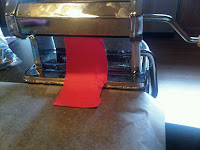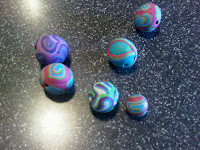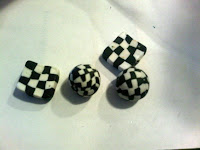This week I decided I wanted to go back to the first clay beading project I attempted, which was a simple flower cane. I decided I wanted to attempt making the flower cane again because, when I made it the first time I did not have the tools and experience that I have that would make the cane aesthetically look better. I wanted to use this as a test to see if my clay skills have improved since the first project, and I would be able to compare how they look. I decided I was going to try and find another website to follow the directions off of and see if that made any difference. So I searched the web and found this great website
http://www.polymerclaycentral.com/cyclopedia/simpleflowercane_mia.html where they had step by step instructions and pictures on how to make a simple flower cane, which was very similar to the one I tried weeks prior. I got my clay station ready by putting down wax paper, and began following each step the website instructed.
The first step was to roll out a log of pink clay and then cut it into 6 equal logs. I noticed on the website the picture of the pink logs looked as if they were white logs with pink wrapped around them. I wanted my cane to look exactly like the one on the website, so instead of following the exact directions I made up my own step. I used my clay extruder tool with the circle plate and extruded a long white log. Then I used the pasta machine, and on the highest setting and rolled out a sheet of pink clay and wrapped the pink sheet around the white log. After the white log was wrapped in the pink sheet, I cut it into 6 equal pieces. I did the same thing for the middle piece of the flower which was yellow clay with pink wrapped around it, but I had to roll it out so it was thinner than the white and pink logs. Without even finishing the project I was able to tell that my clay skills have improved, because I was able to look at a picture and execute how to make my project look just like the picture. For the rest of the steps I followed them exactly as they were stated on the website. The cane was finally finished and I made the first slice into the cane and was ecstatic with my results. This time around my flower cane came out just like the picture and it looked great.
This week’s project was a huge learning experience for me as well as a reassurance that my clay making skills are getting better. By going back and remaking a project that was not much of a success helped me realize that when making such intricate clay designs that it is okay to use tools to help you through the process of your work, and that doing it all by hand without any kind of helpful tools may not have the best resulting look. This project is evidence that using technology to make clay beads helps make the beads more uniform. I wanted to make my beads look uniform and have it look exactly like the picture shown on the website because, when I see the picture on the screen and then look at my actual work and they match up I feel a sense of accomplishment. I feel like I have done the project the exact way I was supposed to. The first time when I made the flower cane I saw that my project did not look like the picture on the website and I felt a sense of failure and was disappointed. Now looking back at the first cane I can now appreciate that I made that cane completely by hand without any tools or technology and although it did not look exactly like the picture on the website it was my own purely handmade creation.
For my next post I think I want to add on to the cane that I made this week, because of the website I used for this week’s project there is an extra part where you can add on to this cane and make it even better. I would also like to try and attempt teaching a friend how to make a cane and see if I have developed enough skills to teach someone and have them successfully create a clay cane.
This is from my first attempt of the flower cane. From my previous post.
These are all the logs I had to make for this flower cane.
This is the successful flower cane!
These are the different kinds of beads I made with my new flower cane!















